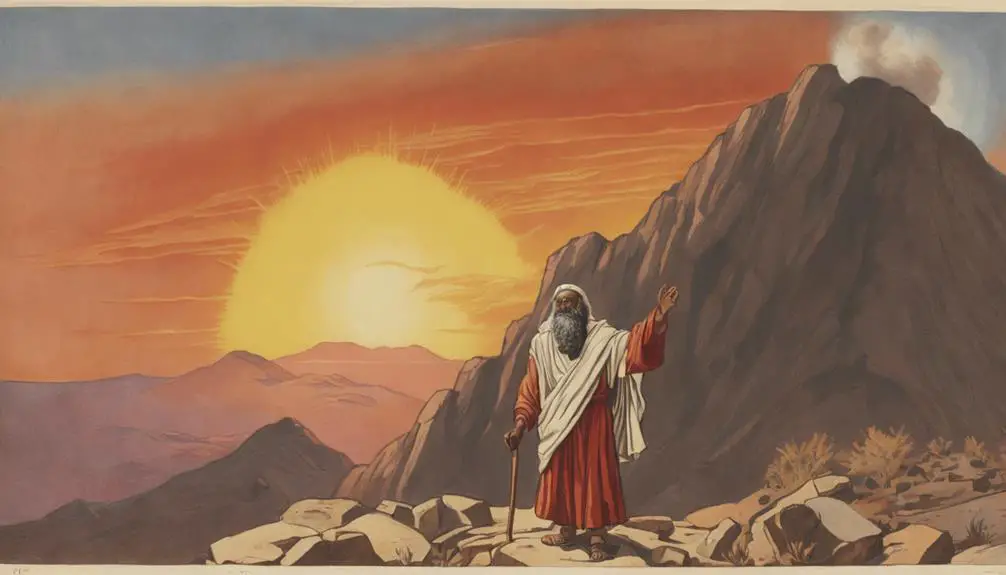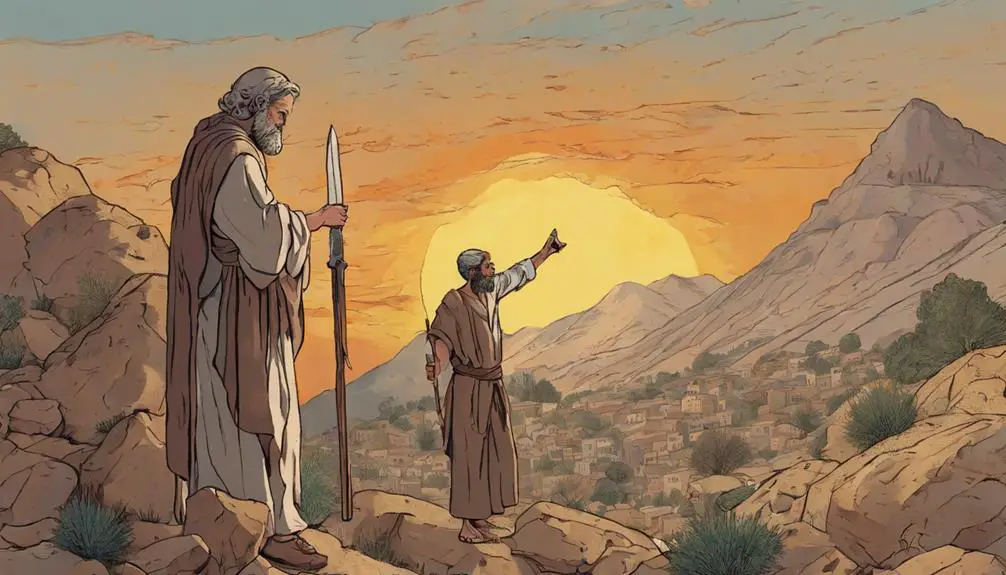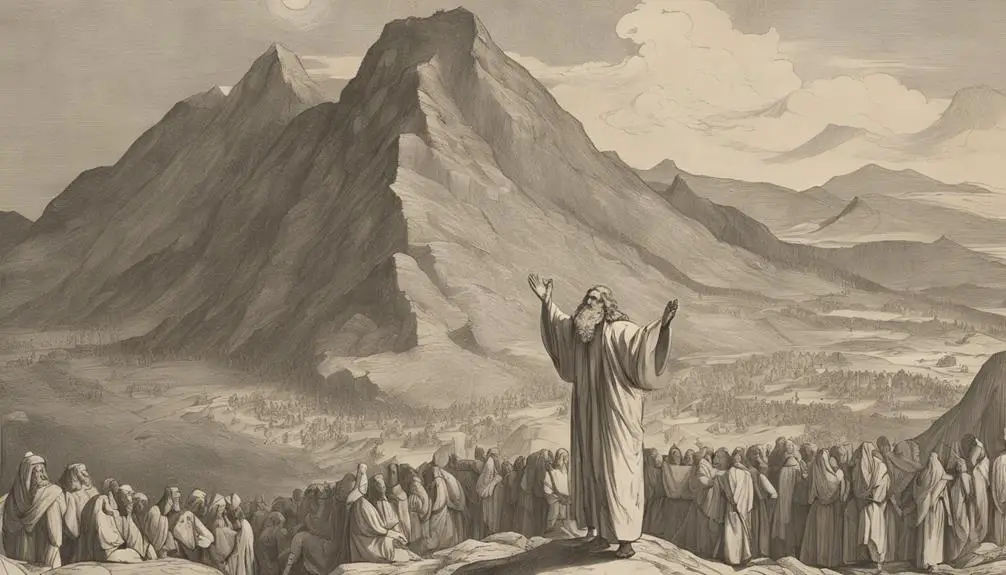Yearning for a deeper understanding of biblical symbolism? Discover the profound significance of mountain top experiences and their impact on your everyday life.

Summit in the Bible
They say life's a climb, but the view's great. You've probably heard this adage before, but have you ever thought about its significance in a biblical context?
Summits, or mountain tops, play a crucial role in the Bible, acting as the stage for pivotal moments and divine revelations. From Moses on Mount Sinai to Jesus' sermon on the Mount, these instances provide profound lessons. But what exactly do these mountain top experiences mean for you in your daily life?
Let's explore this intriguing topic together, you might just find the perspective shift you've been seeking.
Key Takeaways
- Mountains in the Bible symbolize transformation, revelation, and salvation, serving as stages for pivotal divine-human interactions.
- Moses on Mount Sinai, Jesus' Sermon on the Mount, and Abraham's test on Mount Moriah highlight the transformative power of faith.
- These biblical mountain encounters challenge attitudes, call for spiritual growth, and set standards for ethical living.
- The lessons from these biblical summits encourage overcoming challenges with faith, resilience, and deepening the relationship with God.
Biblical Significance of Mountains

Throughout the annals of biblical history, mountains have held a profound significance, often serving as the setting for pivotal events and divine encounters. You've likely come across narratives centered around such high places, emblematic of major shifts and turning points in biblical chronicles.
The Mount Ararat discovery, for instance, is an exemplar of this phenomenon. According to the Genesis account, after the great flood, Noah's Ark rested on Mount Ararat's heights. This event signified a new beginning, a fresh start for humanity after a punishing deluge. This mountain, therefore, represents redemption, hope and the promise of a second chance.
Then, there's the Transfiguration, a significant event in the New Testament that occurred on a mountain. Here, Jesus transfigured into his divine form, his face shining like the sun with clothes becoming as white as light. The Transfiguration significance lies in it being a powerful affirmation of Jesus's divinity, and a preview of His glory in the second coming.
In essence, mountains in the Bible aren't just geographical features. They're monumental stages where divine-human interactions unfold, symbolizing transformation, revelation, and salvation.
Moses and Mount Sinai

Perhaps one of the most monumental biblical events that took place on a mountain is Moses receiving the Ten Commandments on Mount Sinai. This event was preceded by the Burning Bush Encounter, where God revealed Himself to Moses in a burning bush that wasn't consumed by fire.
This encounter led to the escalation of Moses' divine mission, and ultimately, to the Sinai Covenant. Here's a succinct breakdown of these events:
Event |
Description |
|---|---|
Burning Bush Encounter |
Moses encounters a bush that's burning but not consumed. God speaks to him from the bush. |
God's Command |
Moses is instructed to lead the Israelites out of Egypt. |
Moses' Doubt |
Moses expresses doubt about his ability to persuade the people. |
God's Assurance |
God reassures Moses, provides him with miraculous signs. |
Sinai Covenant |
Moses receives the Ten Commandments on Mount Sinai. |
The Sinai Covenant, explained simply, represents the agreement between God and the Israelites, with Moses as the mediator. The Ten Commandments form the core of this covenant, outlining moral and religious duties. This momentous event marked a pinnacle in the Israelites' spiritual journey and still influences religious thought today.
Jesus' Sermon on the Mount

Shifting our focus to the New Testament, we find another significant biblical event that unfolded on a mountain – Jesus' Sermon on the Mount. Here, Jesus laid out moral teachings, encapsulating the essence of his message and setting the standard for Kingdom Ethics.
You'll notice the Beatitudes, the blessings pronounced by Jesus on the humble, merciful, and peacemakers, among others. They're central to the Sermon on the Mount, offering a profound Beatitudes Interpretation. They outline a new set of values, an inversion of the world's common sense where the last are first and the first, last.
Jesus' discourse also includes teachings on prayer, fasting, and almsgiving, warning you against hypocrisy. He emphasizes the need for a righteousness that surpasses the scribes and Pharisees, focusing more on the heart's condition rather than the mere observance of the law.
The Sermon on the Mount is a comprehensive guide to Kingdom Ethics, challenging you to examine your attitudes. It invites you to a transformative journey, from the inside out. It's a call to a higher righteousness, a life that reflects the values and principles of God's kingdom. The Sermon is thus a mountain summit in ethical teaching and spiritual formation.
Mount Moriah: A Test of Faith

In the heart of the Old Testament, you'll encounter an intense narrative of faith and obedience on Mount Moriah, where Abraham's trust in God was put to an extraordinary test. This story dramatically unfolds on Moriah's rocky slopes, vividly illustrating the concept of sacrificial obedience.
Key Elements |
Details |
Significance |
|---|---|---|
Location |
Mount Moriah |
The place where Abraham's faith was tested. |
Act |
Sacrifice of Isaac |
Represents obedience and faith in God. |
Result |
God's intervention |
Shows God's faithfulness and mercy. |
Moriah's Representation |
Test of faith |
Symbolizes trials and tribulations in life. |
Sacrificial Obedience |
Abraham's willingness |
Demonstrates complete trust in God. |
Moriah's representation in this narrative isn't merely geographical. It becomes a symbolic landscape of faith, obedience, and divine intervention. The act of sacrificing his son Isaac is a poignant illustration of Abraham's unwavering commitment to God's commands. Yet, God intervenes, sparing Isaac and providing a ram for sacrifice instead. This intricate interplay between obedience and divine mercy underscores the profound spiritual significance of Mount Moriah, making it a cornerstone in biblical theology.
Applying Summit Lessons Today

Drawing from the profound lessons of Mount Moriah, you might wonder how to apply these insights in today's context. The main themes of overcoming challenges and the pursuit of spiritual growth are timeless, resonating even in our modern struggles.
Overcoming challenges is a key part of the Mount Moriah narrative. In the same vein, you're faced with hurdles every day, ranging from personal issues to professional obstacles. What you can glean from the biblical account is the importance of faith and perseverance. Like Abraham, you've to trust in the process and push through adversity, even when the end isn't in sight. You'll find that this approach not only helps you overcome challenges but also fosters resilience.
Spiritual growth, on the other hand, is an ongoing journey. It's about continually striving to understand your beliefs better and deepen your relationship with God. The story of Mount Moriah teaches you that spiritual growth often comes hand in hand with trials. It's in the difficult moments that your faith is tested and strengthened.
Frequently Asked Questions
What Are Some Other Important Mountains in the Bible Apart From Mount Sinai and Mount Moriah?"
Aside from Mount Sinai and Mount Moriah, there's Mount Ararat, where Noah's Ark landed, and the Mount of Olives, where Jesus often prayed.
Mountain symbolism in the Bible often represents divine encounters or prophecies. For instance, Mount Carmel was a site of Elijah's prophecy.
Biblical mountains in prophecies often point to significant events or spiritual truths. So, you see, mountains aren't just geographical features in the Bible, they've deep symbolic meanings too.
Can You Provide More Examples of Jesus Preaching on Other Mountains Apart From During the Sermon on the Mount?"
Yes, Jesus delivered notable teachings on other mountains. Besides the Sermon on the Mount, He transfigured on Mount Tabor, revealing His divine nature to his disciples.
Another significant Mountaintop teaching occurred on the Mount of Olives, where Jesus foretold the destruction of Jerusalem and his Second Coming.
These events showcase the importance of mountains in Jesus' ministry, serving as platforms for significant teachings and revelations.
What Are Some Modern Day Locations Believed to Be Biblical Mountains?"
You're probably curious about modern day locations linked to biblical mountains.
Mount Ararat in Turkey is believed to be the resting place of Noah's Ark.
Mount Sinai, located in Egypt's Sinai Peninsula, is where Moses received the Ten Commandments.
Mount Nebo in Jordan is said to be where Moses saw the Promised Land.
These examples highlight the importance of Biblical Mount Identification and the ongoing symbolism of summits in the Bible.
Are There Any Specific Rituals or Practices Associated With Summits in the Bible?"
Yes, there are specific rituals associated with summits or high places in the Bible. They're often associated with significant events or divine encounters. Summit symbolism plays a big role in biblical interpretation.
For example, Moses received the Ten Commandments on a mountain top. These places were also used for worship and sacrifice. However, it's important to note that these practices vary widely depending on the particular biblical narrative.
How Has the Concept of Summits in the Bible Influenced Other Religious Beliefs and Practices?"
You're exploring how summit symbolism and Biblical interpretations have influenced other religious beliefs and practices.
It's fascinating to see how the symbolism of reaching a high point, a summit, has permeated into various faiths. This demonstrates the universal appeal of overcoming obstacles and reaching new heights.
From this perspective, you can see connections in the practices and narratives across different belief systems.
Conclusion
So, you see, summits in the Bible aren't just geographical features. They're symbolic stages for pivotal events, lessons of faith, and divine encounters.
From Moses at Mount Sinai to Jesus' Sermon on the Mount, these summits serve as spiritual high points.
As you navigate life's peaks and valleys, remember these biblical lessons. They're not just stories, but life-guiding principles, reminding us of our divine journey and the faith needed to reach our own summits.



Sign up